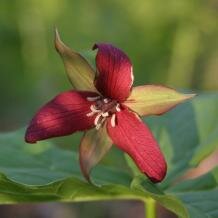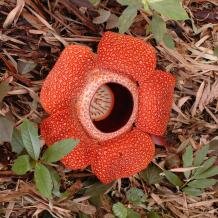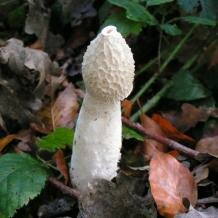Topic: Malodorous flowering plants
Several groups of angiosperms have flower structures that produce foul odours to attract pollinating insects. This strategy is convergent, being found in species as distantly related as the 'Titan arum' Amorphophallus titanium (a monocot) and the 'Corpse flower' Rafflesia (a eudicot).
 Several groups of angiosperms have flower structures that produce foul odours to attract pollinating insects. This strategy of smelling like rotting flesh or faeces is convergent, being found in species as distantly related as the ‘Titan arum’ Amorphophallus titanium (a monocot) and the appropriately named ‘Corpse flower’ Rafflesia (a eudicot). Pungent plants have evolved within a range of flowering plant families, including the Araceae and Melanthiaceae in the monocots, Hydnoraceae in the Magnoliids, and in disparate branches of the eudicots, the Rafflesiaceae and Apocynaceae. In an even more remarkable instance of convergence, a few species of fungi also display foul smelling structures as a solution to spreading their gametes, in this case spores. The following paragraphs provide more details about these pungent organisms.
Several groups of angiosperms have flower structures that produce foul odours to attract pollinating insects. This strategy of smelling like rotting flesh or faeces is convergent, being found in species as distantly related as the ‘Titan arum’ Amorphophallus titanium (a monocot) and the appropriately named ‘Corpse flower’ Rafflesia (a eudicot). Pungent plants have evolved within a range of flowering plant families, including the Araceae and Melanthiaceae in the monocots, Hydnoraceae in the Magnoliids, and in disparate branches of the eudicots, the Rafflesiaceae and Apocynaceae. In an even more remarkable instance of convergence, a few species of fungi also display foul smelling structures as a solution to spreading their gametes, in this case spores. The following paragraphs provide more details about these pungent organisms.
Malodorous monocots: Araceae and Trillium
Inflorescences in the familiy Araceae grow from an underground tuber and typically comprise a leaf-like sheath or ‘spathe’ surrounding a column or ‘spadix’ with many floral structures. The spadix bears female pistils at the base, male stamens above these, and the rest of the column (termed the ‘appendix’) is comprised of sterile ‘staminodes’.  Insects attracted by the plant’s smell and appearance arrive at the base of the spadix where they transfer pollen collected earlier from other flowers of the same species onto the ripe female pistils, so fertilising them. The insects are then trapped overnight, while the pollen in the male flowers ripens; by the morning the female flowers have become unreceptive (preventing self-fertilisation), and the insects are showered in fresh pollen before they leave, equipping them to cross-pollinate another individual. This technique of pollination by insect entrapment is found throughout the Araceae and is often accompanied by phases of heat production (termed ‘thermogenesis’), generated by respiration in the appendix and sometimes male florets.
Insects attracted by the plant’s smell and appearance arrive at the base of the spadix where they transfer pollen collected earlier from other flowers of the same species onto the ripe female pistils, so fertilising them. The insects are then trapped overnight, while the pollen in the male flowers ripens; by the morning the female flowers have become unreceptive (preventing self-fertilisation), and the insects are showered in fresh pollen before they leave, equipping them to cross-pollinate another individual. This technique of pollination by insect entrapment is found throughout the Araceae and is often accompanied by phases of heat production (termed ‘thermogenesis’), generated by respiration in the appendix and sometimes male florets.
 Members of the Araceae that have evolved powerful foul smells and a fleshy appearance come from two groups: the Aroideae and Orontioideae. Aroid examples include the Titan arum (Amorphophallus titanum), Dead horse arum lily (Helicodiceros muscivorus), Dragon lily (Dracunculus vulgaris), Wild arum (Arum maculatus) and Voodoo lily (Sauromatum guttatum), and Orontiods include the Eastern Skunk Cabbage (Symplocarpus foetidus) and Western Skunk Cabbage (Lysichiton americanus). The Titan arum (Amorphophallus titanum), endemic to Sumatran and Indonesian rainforests, is famous for its record breaking giant inflorescence – up to 8ft high and 4 ft wide – and a powerful odour of decaying flesh. The spathe is coloured brown, purple or pale green and covered on its inner surface with ridges and warts that trap or guide insects towards the spadix.
Members of the Araceae that have evolved powerful foul smells and a fleshy appearance come from two groups: the Aroideae and Orontioideae. Aroid examples include the Titan arum (Amorphophallus titanum), Dead horse arum lily (Helicodiceros muscivorus), Dragon lily (Dracunculus vulgaris), Wild arum (Arum maculatus) and Voodoo lily (Sauromatum guttatum), and Orontiods include the Eastern Skunk Cabbage (Symplocarpus foetidus) and Western Skunk Cabbage (Lysichiton americanus). The Titan arum (Amorphophallus titanum), endemic to Sumatran and Indonesian rainforests, is famous for its record breaking giant inflorescence – up to 8ft high and 4 ft wide – and a powerful odour of decaying flesh. The spathe is coloured brown, purple or pale green and covered on its inner surface with ridges and warts that trap or guide insects towards the spadix.  Helicodiceros produces a putrid scent and mimics a dead animal’s hind quarters, even converting part of the spathe into a hairy tail. Helicodiceros attracts carrion beetles and blowflies such as Calliphora and Lucilia. Similar pollinators are attracted by Dracunculus vulgaris, a Mediterranean plant with a downy flesh-coloured spathe and dark purple scent-producing spadix, and the Voodoo lily of tropical Africa and Asia, Sauromatum guttatum.
Helicodiceros produces a putrid scent and mimics a dead animal’s hind quarters, even converting part of the spathe into a hairy tail. Helicodiceros attracts carrion beetles and blowflies such as Calliphora and Lucilia. Similar pollinators are attracted by Dracunculus vulgaris, a Mediterranean plant with a downy flesh-coloured spathe and dark purple scent-producing spadix, and the Voodoo lily of tropical Africa and Asia, Sauromatum guttatum.  The foul scent of Sauromatum is made up largely of volatile terpenes, indoles and amines and ammonia, released most effectively during thermogenesis. The smell attracts insects to the inflorescence, although it has been found that female florets produce a pleasant perfume, perhaps to lure the insects once they are in the floral chamber. Common to Northern Europe is another pungent aroid, the Wild arum or ‘Lords and Ladies’ (Arum maculatum) and its close relative A. italicum or ‘Italian Lords and Ladies’. Arum maculatum has a pale green spathe, purple or yellow spadix and dung-like scent that attracts psychodid midges (primarily Psychoda phalaenoides). The orontioid Lysichiton americanus inhabits wet forests of Western North America, and has a yellow spathe and long cylindrical spadix that produces enough heat to melt snow and spread rotten smelling volatiles. Its close relative from Asia, L. camtschatcense, is identical except for having a white spathe.
The foul scent of Sauromatum is made up largely of volatile terpenes, indoles and amines and ammonia, released most effectively during thermogenesis. The smell attracts insects to the inflorescence, although it has been found that female florets produce a pleasant perfume, perhaps to lure the insects once they are in the floral chamber. Common to Northern Europe is another pungent aroid, the Wild arum or ‘Lords and Ladies’ (Arum maculatum) and its close relative A. italicum or ‘Italian Lords and Ladies’. Arum maculatum has a pale green spathe, purple or yellow spadix and dung-like scent that attracts psychodid midges (primarily Psychoda phalaenoides). The orontioid Lysichiton americanus inhabits wet forests of Western North America, and has a yellow spathe and long cylindrical spadix that produces enough heat to melt snow and spread rotten smelling volatiles. Its close relative from Asia, L. camtschatcense, is identical except for having a white spathe.  The Eastern Skunk Cabbage Symplocarpus foetidus is endemic to wetlands of Eastern North America and has a purple spathe and stout spadix. Scavenging insects are primarily drawn to Symplocarpus by the smell of decay that is released when any of its leaves are crushed, and they are enticed into the floral chamber by heat from the spadix and pleasant scented female flowers.
The Eastern Skunk Cabbage Symplocarpus foetidus is endemic to wetlands of Eastern North America and has a purple spathe and stout spadix. Scavenging insects are primarily drawn to Symplocarpus by the smell of decay that is released when any of its leaves are crushed, and they are enticed into the floral chamber by heat from the spadix and pleasant scented female flowers.
 Outside the diverse Araceae, the only notably rotten-smelling monocot is the Eastern North American species Trillium erectum, a member of the family Melanthiaceae (in the Liliales) known commonly as Stinking Benjamin or Purple trillium. Trillium has underground rhizomes and leaves capable of surviving freezing winters, and its deep red or purple flowers are borne above ground on three leafy bracts, giving off a pungent odour that attracts pollinating flies.
Outside the diverse Araceae, the only notably rotten-smelling monocot is the Eastern North American species Trillium erectum, a member of the family Melanthiaceae (in the Liliales) known commonly as Stinking Benjamin or Purple trillium. Trillium has underground rhizomes and leaves capable of surviving freezing winters, and its deep red or purple flowers are borne above ground on three leafy bracts, giving off a pungent odour that attracts pollinating flies.
Malodorous magnoliids: Hydnora
 Hydnora africana is a parasitic member of the Piperales (family Hydnoraceae) endemic to Southern Africa. Hydnora has no chlorophyll for synthesising food from light, but instead lives underground, parasitizing roots of the Euphorbia family as an ‘endophyte’. A large, fleshy flower is the only part of Hydnora seen above ground, and it emits a dung-like smell to attract its top pollinators, dung and carrion beetles. Convergent with the Araceae, Hydnora traps the beetles temporarily to effect optimum cross-pollination.
Hydnora africana is a parasitic member of the Piperales (family Hydnoraceae) endemic to Southern Africa. Hydnora has no chlorophyll for synthesising food from light, but instead lives underground, parasitizing roots of the Euphorbia family as an ‘endophyte’. A large, fleshy flower is the only part of Hydnora seen above ground, and it emits a dung-like smell to attract its top pollinators, dung and carrion beetles. Convergent with the Araceae, Hydnora traps the beetles temporarily to effect optimum cross-pollination.
Malodorous eudicots: Rafflesia, Stapelia and Hoodia
Within the eudicots we find the two most speciose groups of angiosperms, namely the ‘rosids’ and ‘asterids’. Independent lineages in each of these groups have evolved rotten-smelling flowers to attract their pollinators: Rafflesia in the rosids (family Rafflesiaceae) and in the asterids two genera of Apocynaceae, Stapelia and Hoodia.
 The genus Rafflesia includes around 20 species endemic to South East Asian rainforests that are obligate parasites, unable to photosynthesise. Rafflesia have no leaves, stems or true roots, but extend root-like haustoria inside Tetrastigma vines, gaining all their nutrition from them. The rich nutrition available from this endophytic mode of life permits Rafflesia to produce the largest single flowers in the world (those of R. arnoldii hold the record at >1 metre wide and up to 10kg in weight, and R. tuan-mundae flowers also approach 1 metre in diameter). Rafflesia flowers have 5-petals camouflaged by colour and texture to look like rotting flesh and they produce a foul odour, both factors attractive to carrion flies (e.g. Lucilia and Chrysomya) and beetles. The shapes of the male and female floral organs are adapted so that insects are guided to receive pollen, suspended in a viscous liquid, and then forced to deposit it onto the stigma of another flower.
The genus Rafflesia includes around 20 species endemic to South East Asian rainforests that are obligate parasites, unable to photosynthesise. Rafflesia have no leaves, stems or true roots, but extend root-like haustoria inside Tetrastigma vines, gaining all their nutrition from them. The rich nutrition available from this endophytic mode of life permits Rafflesia to produce the largest single flowers in the world (those of R. arnoldii hold the record at >1 metre wide and up to 10kg in weight, and R. tuan-mundae flowers also approach 1 metre in diameter). Rafflesia flowers have 5-petals camouflaged by colour and texture to look like rotting flesh and they produce a foul odour, both factors attractive to carrion flies (e.g. Lucilia and Chrysomya) and beetles. The shapes of the male and female floral organs are adapted so that insects are guided to receive pollen, suspended in a viscous liquid, and then forced to deposit it onto the stigma of another flower.
 Stapelia gigantea” width=”218″ height=”218″>Among the milkweeds (so called because of their copious production of latex, also convergent) we find Stapelia and Hoodia, both of which are succulent Southern African plants and contain pungent smelling species. Stapelia is a short stem succulent endemic to South Africa and known commonly as the ‘Carrion flower’ or ‘Starfish flower’ after the smell and shape of its 5-petaled blooms. Stapelia flowers are large (up to 40cm diameter in S. gigantea), hairy and smell of decaying animal flesh to attract pollinating blowflies such as Calliphoroa vicina and Lucilia caesar.
Stapelia gigantea” width=”218″ height=”218″>Among the milkweeds (so called because of their copious production of latex, also convergent) we find Stapelia and Hoodia, both of which are succulent Southern African plants and contain pungent smelling species. Stapelia is a short stem succulent endemic to South Africa and known commonly as the ‘Carrion flower’ or ‘Starfish flower’ after the smell and shape of its 5-petaled blooms. Stapelia flowers are large (up to 40cm diameter in S. gigantea), hairy and smell of decaying animal flesh to attract pollinating blowflies such as Calliphoroa vicina and Lucilia caesar.  Hoodia gordonii” width=”218″ height=”218″>Hoodia is in the same small family Apocynaceae, and includes species of cactus-like stem succulents endemic to South Africa and Namibia. Some Hoodia species have pleasant smelling flowers, but the ‘Bushman’s Hat’ Hoodia gordonii has large whitish flowers that smell of rotting meat in order to attract fly pollinators, as in Stapelia.
Hoodia gordonii” width=”218″ height=”218″>Hoodia is in the same small family Apocynaceae, and includes species of cactus-like stem succulents endemic to South Africa and Namibia. Some Hoodia species have pleasant smelling flowers, but the ‘Bushman’s Hat’ Hoodia gordonii has large whitish flowers that smell of rotting meat in order to attract fly pollinators, as in Stapelia.
Malodorous fungi
 Flowers that smell (and in some cases look) like rotting flesh have clearly evolved independently many times within the angiosperms as a strategy to attract specific insect pollinators. The extent of this convergence could be considered even broader if we include those fungi that have taken a similar approach to spreading their gametes (spores rather than pollen). Fungi are only distantly related to animals and even more remote phylogenetically to the plants: so it is striking to note the spadix-like form of the Common Stinkhorn Phallus impudicus and the Dog Stinkhorn Mutinus caninus, a small yet pungent fruiting body from European and North American woodlands.
Flowers that smell (and in some cases look) like rotting flesh have clearly evolved independently many times within the angiosperms as a strategy to attract specific insect pollinators. The extent of this convergence could be considered even broader if we include those fungi that have taken a similar approach to spreading their gametes (spores rather than pollen). Fungi are only distantly related to animals and even more remote phylogenetically to the plants: so it is striking to note the spadix-like form of the Common Stinkhorn Phallus impudicus and the Dog Stinkhorn Mutinus caninus, a small yet pungent fruiting body from European and North American woodlands.  The shape and foul smell of Phallus impudicus attracts similar insects as the plant pollinators, including Calliphora and Lucillia blowflies, which function in spore dispersal. Aseroë rubra, the Sea Anemone Stinkhorn of Australia is reminiscent of Rafflesia, being dominated by a red star-shaped fruiting structure that is foul smelling and camouflaged in colour and texture as animal flesh. Flies attracted to the star become coated in a viscous spore-rich substance, making them excellent spore dispersal agents for the fungus.
The shape and foul smell of Phallus impudicus attracts similar insects as the plant pollinators, including Calliphora and Lucillia blowflies, which function in spore dispersal. Aseroë rubra, the Sea Anemone Stinkhorn of Australia is reminiscent of Rafflesia, being dominated by a red star-shaped fruiting structure that is foul smelling and camouflaged in colour and texture as animal flesh. Flies attracted to the star become coated in a viscous spore-rich substance, making them excellent spore dispersal agents for the fungus.
Cite this web page
Map of Life - "Malodorous flowering plants"
https://mapoflife.org/topics/topic_449_malodorous-flowering-plants/
March 3, 2021

